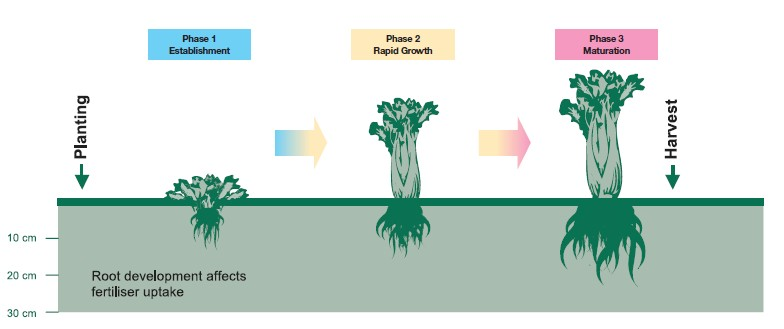Introduction
The research which led to development of the 3Phase fertiliser program started in response to the need to phase out poultry manure because of community concerns with its use in near-metropolitan areas. Although a useful soil amendment and source of nutrients, poultry manure stockpiles provided a breeding ground for stable flies and created odour problems.
This 3Phase fertiliser program is based on four years of fertiliser research on celery grown on the sandy soils of the Swan Coastal Plain with sprinkler irrigation. It gave the highest yields and best quality throughout the year, is practical to apply with mechanised equipment, saves labour and minimises nutrient losses to the environment.
The sandy soils of the coastal plain provide a free-draining, easily worked growing medium. Nutrients are freely available in the soil solution. Some nutrients are highly mobile and easily lost through leaching. Nitrate-nitrogen is particularly susceptible to leaching and is a major groundwater pollution concern.
A good commercial fertiliser program should:
- maximise yield and quality with minimum fertiliser input and cost
- minimise adverse off-site effects, including loss through leaching, wind drift or overspray.
The 3Phase fertiliser program is based on research conducted on some of the most infertile sandy soils in Australia and is aimed at developing cost-effective strategies for producing high yield in a ‘worst case’ situation.
Trial sites chosen for this research had no previous vegetable cropping history and irrigation water did not contain nutrients from past cropping activities. No soil amendments such as compost and manure were used (except as commercial controls), but trials were grown in rotation with lettuce and broccoli and there was some carryover of nutrients from crop residues.
Fertiliser and cost savings are achieved in the 3Phase program by making informed choices about fertiliser type, application rates, methods and timing — matching fertiliser application to crop demand. To achieve this, the life of the crop is considered in three phases: establishment, rapid growth and maturation (Figure 1).
Different fertiliser strategies are used to optimise growth in each of these phases and meet the criteria of a ‘good program’.



